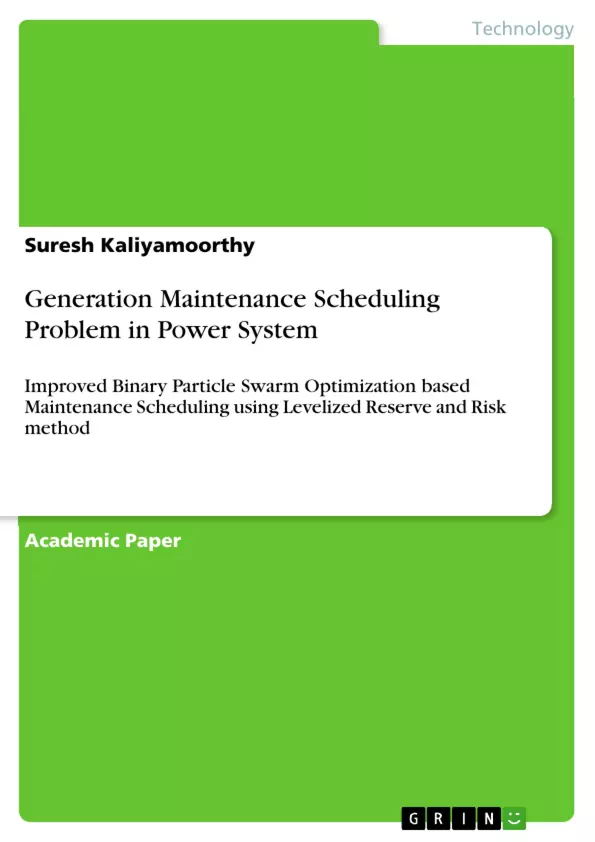The fundamental concern of Maintenance Scheduling (MS) is to reduce the generator failures and extend the generator’s lifespan thereby increasing the system reliability. The objective function of MS problem is to reduce the LOLP and minimizing the annual supply reserve ratio deviation for a power system which are considered as a measure of power system reliability. The typical Particle Swarm Optimization (PSO) is designed for continuous function optimization problems, and not for discrete function optimization problems. The MS problem has discrete decision variables. Hence, the Improved Binary PSO (BPSO) is utilized to solve the MS problem. Furthermore, Improved BPSO (IBPSO) based and levelized reserve rate methods are developed to solve the MS problem. In order to test the effectiveness of the IBPSO based MS method IEEE Reliability Test System (RTS) case study is considered
A comparison is made between the MS results obtained from the levelized reserve and the levelized risk methods. Consequently, the comparison reveals that the levelized risk method is obviously superior to the levelized reserve rate method which is deterministic methods neglect the influence of the generating unit’s random outages.
The IBPSO generates optimal MS solution and overcomes the limitation of the conventional methods such as extensive computational effort which increases significantly as the size of the problem increases. The proposed method yields better result by means of improved search performance and better convergence characteristics which are compared to the other optimization methods and conventional method.
Inhaltsverzeichnis (Table of Contents)
- Preface
- Improved Binary Particle Swarm Optimization based Maintenance Scheduling using Levelized Reserve and Risk method
- Abstract
Zielsetzung und Themenschwerpunkte (Objectives and Key Themes)
This research aims to improve the efficiency and effectiveness of Maintenance Scheduling (MS) in power systems by utilizing an Improved Binary Particle Swarm Optimization (IBPSO) algorithm. The goal is to reduce generator failures, extend generator lifespan, and enhance system reliability through optimal maintenance scheduling.
- Optimization of Maintenance Scheduling using Improved Binary PSO (IBPSO)
- Minimizing Loss of Load Probability (LOLP) and annual supply reserve ratio deviation
- Comparison of levelized reserve and levelized risk methods for MS
- Evaluation of IBPSO's effectiveness in addressing the limitations of traditional methods
- Enhancement of search performance and convergence characteristics in the MS problem
Zusammenfassung der Kapitel (Chapter Summaries)
- Preface: This chapter introduces the importance of Maintenance Scheduling (MS) in power systems, highlighting its significance in ensuring system reliability and preventing costly unplanned outages.
- Improved Binary Particle Swarm Optimization based Maintenance Scheduling using Levelized Reserve and Risk method: This chapter presents an improved binary particle swarm optimization (IBPSO) algorithm designed to address the limitations of traditional methods in solving the MS problem. It introduces the concepts of levelized reserve and levelized risk methods for evaluating the effectiveness of different MS solutions.
- Abstract: This section provides a brief overview of the research work, focusing on the key objectives, methodologies, and findings. It highlights the development of an IBPSO-based MS method and its application to the IEEE Reliability Test System (RTS) case study.
Schlüsselwörter (Keywords)
The main focus of this research is on the application of Improved Binary Particle Swarm Optimization (IBPSO) for solving the Maintenance Scheduling (MS) problem in power systems. Key terms include Loss of Load Probability (LOLP), levelized reserve and levelized risk methods, and the evaluation of the proposed method's effectiveness in comparison to traditional methods.
- Citation du texte
- Suresh Kaliyamoorthy (Auteur), 2015, Generation Maintenance Scheduling Problem in Power System, Munich, GRIN Verlag, https://www.grin.com/document/493401



